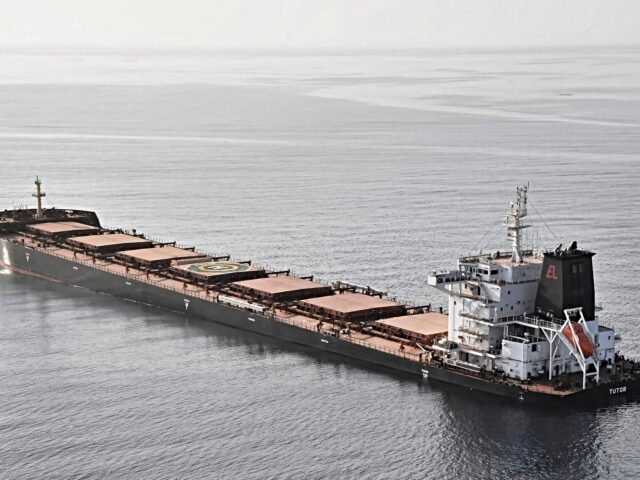United Kingdom Maritime Trade Operations (UKMTO) said on Tuesday that the Greek-owned coal carrier MV Tutor, struck by Houthi missiles and an unmanned surface vehicle (USV) on July 12, has sunk in the Red Sea.
The Tutor became the second ship sunk by the Iran-backed Yemeni terrorists since they began their campaign of wanton attacks on commercial shipping in November. It also appears to have been the first ship to be severely damaged by a Houthi USV attack. The weapon was evidently a remote-controlled small boat packed with explosives.
The Houthis attacked the Tutor while it was sailing about 66 miles southwest of Yemen’s port city of Hodeidah. UKMTO quickly reported it was one of the most devastating attacks launched by the Houthis to date, as the ship went adrift and began taking on water.
One member of the mostly Filipino crew was reportedly trapped in the damaged engine room, while the rest were rescued by the U.S. Navy on Sunday and airlifted to the carrier USS Dwight D. Eisenhower.
Safety of life at sea is a sacred obligation for all mariners. The IKE Carrier Strike Group lived that ethos June 15, helping the crew of MV Tutor after they were attacked by Iranian-backed Houthis in the Red Sea. @TheCVN69 #MightyIKE
Read more⬇️https://t.co/hyU5gJoX9f pic.twitter.com/gqc6n5cJyb
— U.S. Naval Forces Central Command/U.S. 5th Fleet (@US5thFleet) June 16, 2024
“Military authorities report maritime debris and oil sighted in the last reported location. The vessel is believed to have sunk,” UKMTO said in a situation update on Tuesday.
On Wednesday, salvage company owner Andreas Tsavliris told Reuters that two of his vessels en route to the Tutor were informed by U.S. and allied naval forces that the ship sank, so they “abandoned the mission.”
The U.S. military has not made a public statement about the sinking of the Tutor as of Wednesday morning and neither have the Houthis, although Houthi-controlled media quoted foreign media outlets reporting the sinking on Wednesday.
The Philippine Department of Migrant Workers (DMW) said on Wednesday that search-and-rescue operations for the missing Tutor crewmember are underway. DMW Secretary Hans Leo Cacdac mentioned reports that the missing man was trapped in the engine room and suggested the search would begin there, although sadly he made that statement before UKMTO reported the sinking of the ship.
The U.S. government said on Monday that the missing crewmember was presumed dead, but Philippine officials said they would not confirm his death until the body was recovered.

File – Houthi rebel fighters march during a rally of support for the Palestinians in the Gaza Strip and against the U.S. strikes on Yemen outside Sanaa on Jan. 22, 2024. (AP Photo, File)
The first vessel sunk by Houthi terrorists was the British-owned, Belize-flagged cargo ship Rubymar, which was hit by Houthi missiles on February 18. The crew quickly abandoned ship and was safely evacuated.
The internationally-recognized legitimate government of Yemen, which was driven out of the capital by an Iran-supported Houthi insurrection in 2014, said the Rubymar went under on March 2, due to a combination of damage from the attack, “weather factors,” and “strong winds at sea.”
The Rubymar was carrying 21,000 metric tons of ammonium phosphate sulfate fertilizer, so its sinking created an “environmental risk in the Red Sea,” according to the U.S. Central Command (CENTCOM). The Houthis said blame for the attack should be laid on the British government, because it supports Israel’s military operation against Hamas terrorists in Gaza.
“It’s a new disaster for our country and our people. Every day, we pay for the Houthi militia’s adventures, which were not stopped at plunging Yemen into the coup disaster and war,” Ahmed Awad bin Mubarak, prime minister of the legitimate Yemeni government, said when the Rubymar sank in March.

COMMENTS
Please let us know if you're having issues with commenting.